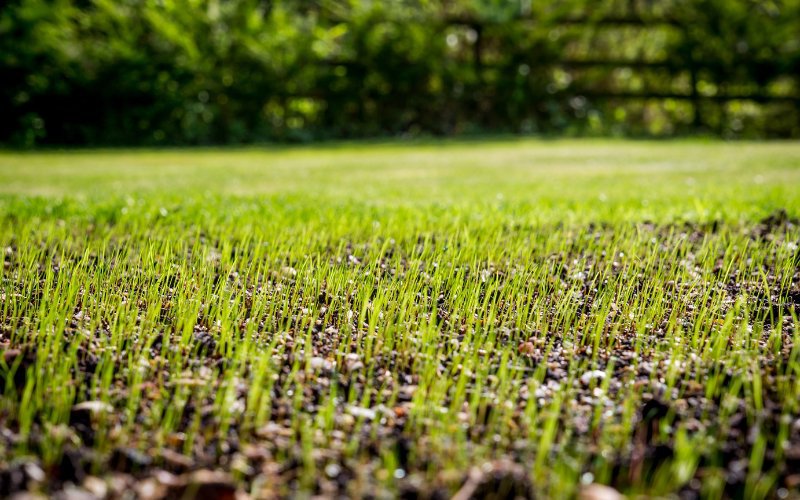If you’re not used to gardening or you’ve only ever kept mature houseplants indoors, the rate at which grass develops may surprise you.
While all grass types do grow at slightly different rates, all stages contain roughly the same type of development and markers to keep watch for.
A detailed summary of what these stages are as well as when to worry can be found in the article below.

Grass Seed Germination Day-by-Day (A Summary)
The germination process can take 3 days if you have chosen a fast-growing grass variety or 30 days if you have a slow-growing variety.
The first stage, absorption of water, and the rest and metabolic activation stages after this, take the most time. Then the seed coat will be broken and the radicle will emerge. Growth takes off after this.
Grass Seed Germination Stages (This is What Should Happen)
The phrase “watching the grass grow” means something is boring for good reason. Not a lot happens during the germination process or early stages of growth.
This isn’t nearly as interesting as watching large leaves unfurl from small bean seeds or seeing pea shoots pop up and reach several inches in height in a matter of days.
Grass seed germination is slow and steady, as the phrase mentioned above would suggest.
This grass seed germination process can be broken up into 3 stages. These stages of grass seed growth are detailed below.
Stage 1: Water Absorption (aka Imbibition)
The first thing you need to do after planting your grass seeds is to water them. This is because the germination process cannot begin without enough water.
During the imbibition stage, the seed rehydrates itself by absorbing water. The grass seed will appear slightly swollen during this stage and through stage 2.
This process can take 48 hours or an entire week.
Stage 2: Rest and Metabolic Activation
This is the stage that can take some seeds so long to get through. For example, Zoysia grass takes about 20 days to produce a radicle (the first root-like structure) and move on to stage 3.
In stage 2 of grass seed germination, the seed will appear swollen and then will split. This stage will not trigger without enough warmth.
Inside the seed coat, the seed has started to metabolize the nutrients and resources it contains within its shell.
It will then reach out into the soil or other growing medium with a radicle or initial root. This radicle will attempt to absorb more water and nutrients in preparation for stage 3.
Stage 2 should take roughly 5 days to 2 weeks to complete, on average.
Stage 3: Shedding the Seed Coat and Sprouting
As the seed moves through stage 2 and establishes itself, its seed coat will split and then be shed. This indicates the start of stage 3.
Stage 3 is the “showiest” stage as this is when the grass seed sprouts and becomes a grass sprout or seedling.
It will produce its initial blade or blades of grass as these are the leaves it needs to start the photosynthesis process and feed itself.
Stage 3 should take 1 to 5 days to complete, on average.
Factors That Can Influence the Stages of Grass Seed Growth
The below factors can greatly influence how long it takes for different grass types to germinate.
Moisture Can Speed Up or Halt Grass Growth
As mentioned above, all seeds need sufficient water to germinate. This helps soften the seed coat and start the metabolic process that will eventually cause the seed to sprout.
Without enough moisture or consistent hydration, your side, like any other plant, will become dehydrated and deteriorate.
Temperature Can Speed Up or Halt Grass Seed Growth
Different varieties of grass seeds need different temperature ranges to sprout. Most, however, need temperatures of at least 50F along with sufficient hydration to begin the germination process.
Grass Seed Age and Viability Can Influence Grass Growth
Grass seeds that are too old or that have begun to deteriorate will germinate more slowly than other types and may spend significantly longer in phase 2 and will require more water than fresh seeds.
This is because older seeds may have lost an internal protective barrier that helps them retain moisture or run low on necessary nutrients and stored energy.
Light Can Speed Up Grass Growth
Many grass varieties require a small amount of light to trigger the germination process. Even if they do not, light helps encourage grass seedlings to send up leaves quickly and move from stage 2 to stage 3.
Environmental Factors and Substances Can Stop Germination and Growth
Many herbicides as well as products like corn gluten meal can stop germination in its tracks, even up to a year after application.
This is because many of these substances stay in the soil and disrupt the hormones plants use to trigger and complete the germination process.
When You Should Be Worried
If your grass seed is not behaving as you would expect, even after reading the information provided above, there may be cause for concern.
Below is a list of reasons you should be concerned about abnormal growth patterns or germination outcomes.
If you encounter any of these situations or if you want more detailed information about why your grass seeds might not be germinating and what you can do about it, check out this other article.
- You Smell Mold or the Ground Is Perpetually Wet – Mold, mildew, and long-standing damp conditions can overwhelm seedlings and sprouts leading to a condition known as “damping off”.
- Your Grass Seedlings Have Dried Up and Curled – Young plants of all kinds need consistent access to moisture. Without this, they can dry up and die back within a day, if the temperature is hot enough or there is constant wind.
- There are Brown or Black Spots on Your Seedlings – If there is too much of a rich nutrient in your soil, the acidity is too high, or there is the presence of disease, you may notice that your seedlings are discolored.
- There Has Been No Sign of Growth in 45 Days or More – Producing a single guide to grass seed germination day-by-day that is accurate across more than a handful of species is impossible, but it is possible to know when it has been far too long for grass seeds to sprout. That cutoff is 45 days. No grass seed variety in good health should take longer than 45 days to complete the germination cycle as described in the phases above.
- Your Grass Seeds Have Completely Germinated in a Few Patches – If there are a handful of bare patches and a handful of places where your grass seeds have completed the germination process, do not hold out hope that these bare patches will suddenly germinate. Chances are high that the seeds in these zones were eaten, washed away, or otherwise rendered non-viable.


Leave a Reply